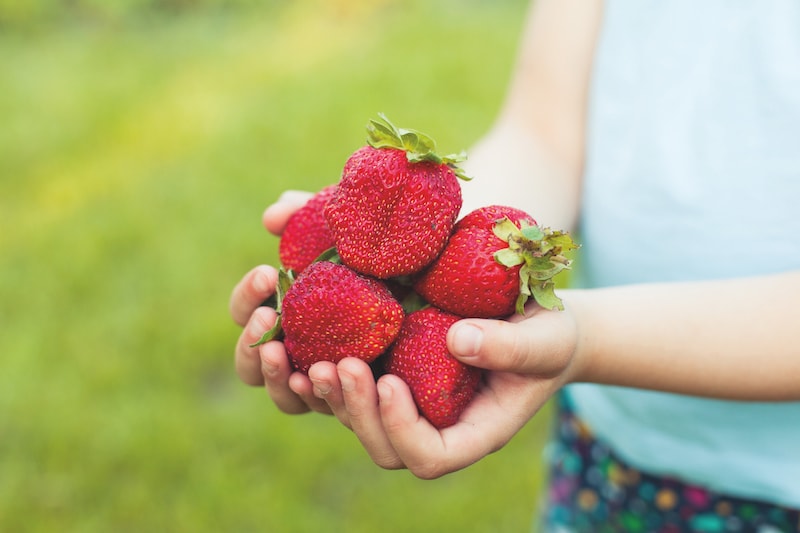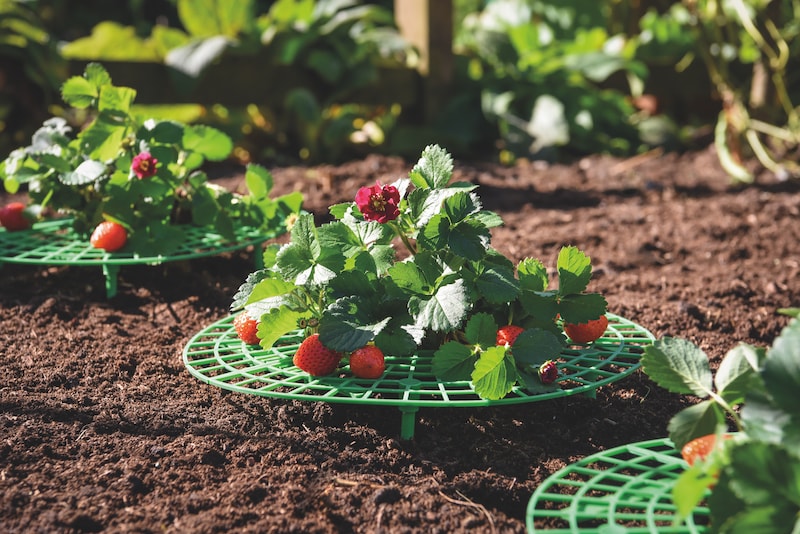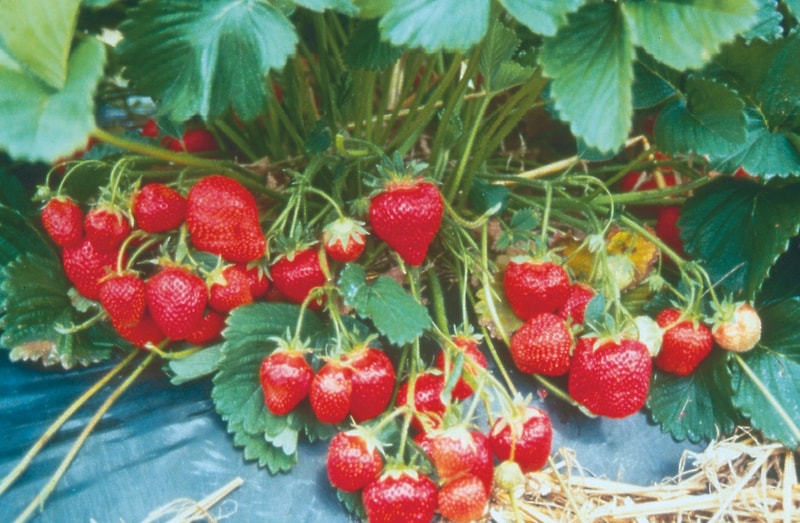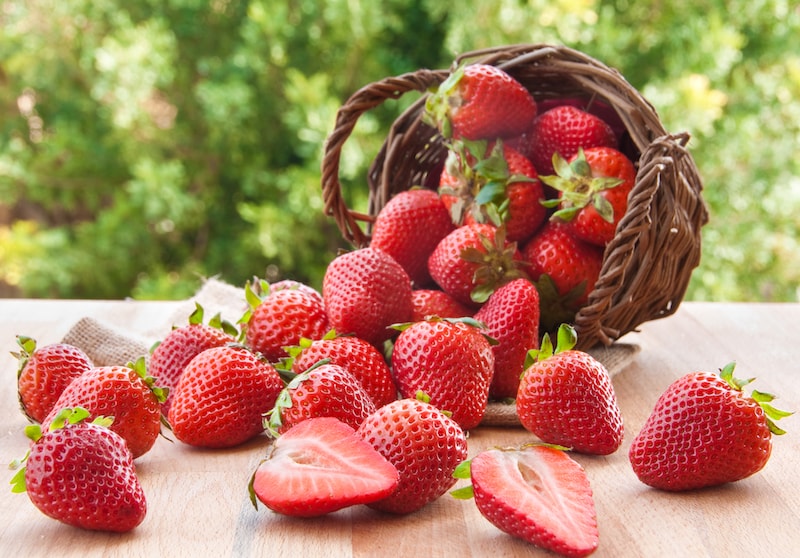If you’re looking for advice to help you grow delicious strawberries, this is where you’ll find it. We’ve selected the best strawberry-related content from across the online gardening community and assembled it all in one easy-to-access place – right here. Read on to discover everything you need to help you choose, plant, grow and care for your strawberry plants.
Contents:
- Best advice on which strawberries to grow
- Best advice on how to plant strawberries
- Best advice on how to care for strawberries
- Best advice on strawberry pests and diseases
Best advice on which strawberries to grow

Image: Strawberry ‘Sweet Colossus’ from Suttons
Strawberries are one of the best crops to grow with kids or grandkids, says Donna from What the Redhead Said. Packed with top tips for growing them with children, she says, “skip the seeds and buy a tray of strawberry plants instead. They don’t cost much – just a couple of pounds – but it will be so much easier than growing strawberries from seed.”
Buy your strawberries as dormant bare roots, plugs, or, once spring is underway, garden ready plants, says Tony of Simplify Gardening. He’s a big fan of strawberry plug plants, which arrive ready to thrive the moment you plant them into the soil. In his video, Tony showcases one of his favourite varieties, Strawberry ‘Sweet Colossus’. His advice – once your plug plants arrive, get them into the ground as soon as possible.
Because the strawberries you buy from the supermarket are often picked before they’re fully ripe, they can’t compete with homegrown ones for taste and sweetness, says Ben Vanheems of GrowVeg. He says strawberries fall into two categories – June bearing and perpetual or everbearing which produce two smaller crops, one at the beginning and another towards the end of summer. In his excellent video guide to producing wonderful crops of strawberries, he advises choosing a mixture to guarantee a supply of fruit all summer long.
If you’d like an early crop of succulent strawberries, veteran gardening columnist Alan Down at Down to Earth offers his pick of the best. Recommending ‘Cambridge Favourite’, and ‘Honeoye’, he explains that in order to force early cropping, you should plant healthy runners into grow bags during the autumn. Leave these outside until the end of the year, and then bring them into the greenhouse or conservatory.
Best advice on how to plant strawberries

Image: Strawberry Supports from Suttons
If you’re planting strawberry plugs or plants, John Harrison of Allotment & Gardens says the key is to avoid going too deep which can make the roots rot. Instead, “make a shallow hole and mound up soil in the centre, to just above the soil level. Place the strawberry on the mound, spread the roots down the sides and gently firm in soil to cover the roots. Space your plants about 20–25 cm (8–10 inches) apart.”
Here at the Suttons blog, our team of horticultural experts gives you the lowdown on matted row culture, as well as tips for growing in pots and forcing an early crop. New to matted row culture? Our experts explain: “Instead of removing the runners, retain up to nine per plant, arranging them so that they root in the soil between the plants within the row.” This works for all varieties (except 60 day runners) and results in heavier crops.
Strawberries take their name from the beds of straw into which they were planted to protect the fruit from slugs, says Simon Eade of The Garden of Eaden. If straw isn’t an option for you, pots are a great alternative, says Simon: “The main benefit of pot grown fruit is that they can be moved away from areas of high risk and [pots] also take copper bands which will prevent slugs and snails from climbing the pot and reaching the fruit.” Head over to Simon’s excellent blog for detailed instructions for growing this way.
Another way to protect fruit from slugs is to plant your strawberries in hanging baskets, which are also a great space-saver. Carol at The Sunday Gardener recommends using hanging baskets with a built-in reservoir at the bottom to help keep your plants and swelling fruit hydrated. Well worth a watch, Carol’s video also explains how to hand-pollinate strawberries when growing them under glass.
If you’ve inherited strawberry runners in pots, it’s definitely worth heading over to the YouTube channel, Greenside Up where Dee Sewell demonstrates how to clean, trim, check over, and plant them. As it’s pouring with rain, her piece also demonstrates the advantages of planting your strawberries in a polytunnel. To avoid diseases, she says, leave plenty of space between plants to ensure good air flow.
Best advice on how to care for strawberries

Image: Strawberry ‘Albion’ from Suttons
Watering is key to ensuring an abundant harvest of juicy summer strawberries, says the team here at the Suttons blog. With this in mind, “do keep an eye on the weather and if conditions are dry, make sure you water your strawberries regularly, especially while the fruit is swelling and ripening, otherwise the strawberries will be of poor size and quality.”
It only takes a little effort to care for your strawberries once they’ve finished fruiting, says John from Pyracantha. Doing so keeps your plants healthy so that they fruit well the following year. His advice is to remove the netting and the straw or mulch after fruiting to allow air to circulate and prevent pests from hiding. Head over to his blog for more tips on looking after strawberry plants.
There are some neat winter-time tricks to help you get a head start on your summer garden, says Andrew Oldham at Life on Pig Row. Winter is the time to check for runners your strawberries sent out this year, and transfer some to your greenhouse for forcing. “This summer they will be two years old,” Andrew explains, “and strawberries do their best fruiting in their second and third years.”
Moving strawberry plants from an overcrowded patch to a new area? Jana Louise Smit of dengarden offers some great advice: “Don’t press the shovel too closely to the stem when digging out the plant. Ideally, one should push the shovel in once and deeply. Then lift the plant free.” To avoid weather stress, Jana also advises choosing a day when it’s not too hot or windy.
Strawberry plants yield less fruit after the first three years and must be replaced. One way to do this is to transfer strawberry runners from one bed to a fresh bed, then dig up and dispose of the old plants. If you’ve never done this before, check out the YouTube channel Urban Allotment, where gardener Lauksie demonstrates how to get the job done efficiently, giving each plant a square foot of space to itself to give it the best chance of producing a bountiful crop.
During fruiting and ripening, your strawberry plants will ”benefit from a standard feed, once or twice over that period,” says the team at Thrive. This helps to maximise your harvest and “feeding may encourage further cropping across the season.” Once your plants send out runners, you should also “use cloche pegs, bent garden wire or even hairpins” to keep the baby plants in contact with the soil to encourage rooting. These young plants will later replace their parents.
Best advice on strawberry pests and diseases

Image: Strawberry Plants ‘Marshmello’ from Suttons
Unless you cover your strawberries, birds will make short work of them, says Ben Vanheems over at GrowVeg. The best way to protect them, he explains, is to “cover them with netting which excludes birds but still allows pollinating insects to pass through.” He also recommends keeping an eye on the weather so, if a cold snap threatens early blossoms, you can cover your plants with horticultural fleece. Finally, slug traps filled with beer will help to attract slimy predators away from your strawberry crop.
Sam over at @samthedreamer learned the hard way to protect her crop from being “eaten by little trolls.” Thankfully, this year, she’s netted her strawberry crop and the results speak for themselves. Head over to Sam’s feed for a look at the difference a little bit of netting makes. As Sam says, “this photo makes me happy!”
Fed up with “feeding the wildlife” with her strawberry crop, Lauren at City Self-Sufficiency now opts to grow hers inside a polytunnel. Her video demonstrates how she raises her plants up off the ground using bricks to support containers full of precious strawberry plants well away from birds, slugs, snails, rats and anything else that likes strawberries (everyone).
Over at Greenside Up, YouTuber and gardener Dee Sewell explains that strawberries are prone to vine weevil attacks. To protect your crop, before you plant strawberries, be very careful to check plants for withered leaves, grubs hiding among the roots, and notches nibbled in the edges of the leaves. If you notice any of these signs of vine weevil infestation, jettison the plant or treat it with nematodes.
We hope you’ve picked up some useful information from our collection of online gardeners, ready to plant your own crop of delicious strawberries. In the unlikely event that you’re still unsure whether to bother with strawberries this year, head over to Claire Thomson’s Insta, @5oclockapron, where you’ll discover the clincher – jars full of summer goodness – strawberry jam! As Claire says, “Worth it, every time.”
Lead image: Strawberry Plants ‘Malling Centenary’ from Suttons




great tips. -I’m getting good results with Aquaponics too!
I featured your article in my newsletter for those that want to try method other than aquaponics: https://www.veg-geek.com/newsletters/13052022 😉
This blog is very helpful.i loved it